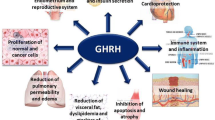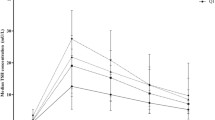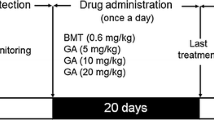Summary
Thyrotropin-releasing hormone (TRH; protirelin) is the smallest known peptide hormone. It has central effects, unrelated to its endocrine effects, via an action at the pituitary-thyroid axis.
TRH has been used successfully to treat children with neurological disorders including intractable epilepsy. The effectiveness of TRH, and an analogue of the peptide (DN-1417), has been reported as both add-on and monotherapy in the treatment of progressive myoclonic epilepsy, West syndrome, Lennox-Gastaut syndrome, complex partial seizures, severe myoclonic epilepsy in infancy, and early infantile epileptic encephalopathy. No serious adverse effects have been reported. TRH may, thus, be considered to be a possible treatment for intractable epilepsy, especially for children with West syndrome and Lennox-Gastaut syndrome. However, it should be noted that the studies were not placebo-controlled or double-blind in design, and most were performed in Japan (the peptide has not been widely studied as a treatment for epilepsy in other countries).
The relatively prolonged duration of action of TRH may indicate that the mechanism of its anticonvulsant action differs from that of other anticonvulsant drugs. It is likely that TRH contributes to the plasticity of the seizure network, in analogy to its known trophic effect on spinal motoneurons. Additional research is required to further elucidate the mechanism of action of TRH in children who have epilepsy that is refractory to conventional treatment, and further efforts should be made to develop more potent and selective TRH analogues for neurological disorders.
Similar content being viewed by others
References
Winokur A, Utiger RD. Thyrotropin-releasing hormone, regional distribution in rat brain. Science 1974; 185: 265–6
Nienwenheys R. Chemoarchitecture of the brain. Berlin: Springer, 1985
Metcalf G. Regulatory peptides as a source of new drugs — the clinical prospects for analogues of TRH which are resistant to metabolic degeneration. Brain Res Rev 1982; 4: 389–408
Schimmer BP, George SR. Thyroid hormones and anti-hyperthyroid drugs. In: Kalant H, Roschlau WHE, editors. Principles of medical pharmacology. Toronto, Philadelphia: BC Decker Inc, 1989: 444–50
Simasko SM. Pituitary hormones. In: Smith CM, Reynard AM, editors. Textbook of pharmacology. Philadelphia: Saunders, 1992: 664–82
Nemeroff CB, Prange AJ, Biissete GJ, et al. Thyrotropin-releasing hormone (TRH) and its alanine analogue: potentiation of the anticonvulsant potency of phenobarbital in mice. Psychopharmacol Commun 1975; 1: 305–17
Agarwal RA, Rastogi RB, Singhai RL. Enhancement of locomotor activity, and catecholamine and 5-hydroxytryptamine metabolism by thyrotropin-releasing hormone. Neuroendocrinology 1977; 23: 236–47
Kerwin RW, Pycock CJ. Thyrotropin-releasing hormone stimulates release of [3H]dopamine from slices of rat nucleus accumbens in vitro. Br J Pharmacol 1979; 67: 323–5
Rastogi RB, Singhal RL, Lapierre YD. Effects of MK-771, a novel TRH analog, on brain dopaminergic and serotonergic systems. Eur J Pharmacol 1981; 73: 307–12
Sharp T, Bennett GW, Marsden CA. Thyrotropin-releasing hormone analogues increase dopamine release from slices of rat brain. J Neurochem 1982; 39: 1763–6
Yamashita K, Mori A, Otsuki S. Changes in brain thyrotropinreleasing hormone (TRH) of seizure-prone El mice. Exp Neurol 1990; 108: 71–5
Sato M, Morimoto K, Wada JA. Antiepileptic effects of thyrotropin-releasing hormone and its new derivative, DN-1417, examined in feline amygdaloid kindling preparation. Epilepsia 1984; 25: 537–44
Morimoto K, Goddard GV. Effects of thyrotropin-releasing hormone on evoked responses and long-term potentiation in the dentate gyrus of rat. Exp Neurol 1985; 90: 401–10
Ogawa N, Hirose Y, Mori A, et al. Involvement of thyrotropinreleasing hormone (TRH) neural system of the brain in pentylenetetrazol-induced seizures. Regul Peptides 1985; 12: 249–56
Kubek MJ, Low WC, Sartin A, et al. Role of TRH in seizure modulation. Ann NY Acad Sci 1989; 553: 286–303
Kubek MJ, Knoblach SM, Sharif NA, et al. Thyrotropin-releasing hormone gene expression and receptors are differentially modified in limbic foci by seizures. Ann Neurol 1993; 33: 70–6
Kalivas PW, Halrern LM, Horita A. Synchronization of hippocampal and cortical electroencephalogram by thyrotropin-releasing hormone. Exp Neurol 1980; 69: 627–38
Tonoue T, Nishimura H, Tokushige K, et al. Thyrotropin-releasing hormone-induced changes in electroencephalographic and vagal activity in the cross-circulated brain of the rat. Brain Res 1986; 378: 394–7
Lagenstein I, Willing RP, Kuhne D. Reversible cerebral atrophy caused by corticotropin. Lancet 1979; 1: 1246–7
Lyen LR, Holland IM, Lyen YC. Reversible cerebral atrophy in infantile spasms caused by corticotropin. Lancet 1979; 2: 37–8
Riikonen R, Donner M. ACTH therapy in infantile spasms: side effects. Arch Dis Child 1990; 55: 664–72
Inanaga K, Inoue Y. Effect of thyrotropin-releasing hormone analog in a patient with myoclonus epilepsy. Kurume Med J 1981; 28: 201–10
Maeda K, Tanimoto K. Epileptic seizures induced by thyrotropin-releasing hormone. Lancet 1981 May 9; 8221: 1058–9
Takeuchi Y, Fujiwara K, Ishimura K, et al. Efficacy of thyrotropin-releasing hormone in the treatment of cerebellar ataxia. Pediatr Neurol 1989; 5: 107–10
Takeuchi Y, Miyanomae Y, Komatsu H, et al. Efficacy of thyrotropin-releasing hormone in the treatment of spinal muscular atrophy. J Child Neurol 1994; 9: 287–9
Sobue I, Yamamoto H, Kanagawa M, et al. Effects of thyrotropin-releasing hormone on ataxia of spinocerebellar degeneration. Lancet 1980; 1: 418–9
Banda R, Means E, Samaha FJ. Trophic effect of thyrotropin-releasing hormone on murine ventral horn neurons in culture. Neurolology 1985; 35 Suppl. 1: 93
Schmidt-Ackert KM, Askanas V, Engel WK. Thyrotropin-releasing hormone enhances choline acetyltransferase and creatinine kinase in cultured spinal ventral horn neurons. J Neurochem 1984; 43: 586–9
Feden AI, Jacobs TP, Holaday JW. Thyrotropin-releasing hormone improves neurologic recovery after spinal trauma in cats. N Engl J Med 1981; 305: 1063–7
Faden AI, Jacobs TP, Smith MT. Thyrotropin-releasing hormone in experimental spinal injury: dose response and late treatment. Neurology 1984; 34: 1280–4
Lawrence HP, Amy R, Gary AC, et al. Treatment with thyrotropin-releasing hormone (TRH) in patients with traumatic spinal cord injuries. J Neurotrauma 1995; 12: 235–43
Rosen JB, Weiss SR, Post RM. Contingent tolerance to carba-mazepine: alteration in TRH mRNA and TRH receptor binding in limbic structures. Brain Res 1994; 651: 252–60
Marangell LB, George MS, Bissette G, et al. Carbamazepine increases cerebrospinal fluid thyrotropin-releasing hormone levels in affectively ill patients. Arch Gen Psychiatry 1994; 51: 625–8
Wada JA, Sato M, Wake A, et al. Prophylactic effects of phenytoin, phenobarbital and carbamazepine examined in kindling cat preparation. Arch Neurol 1976; 33: 426–34
Patriciade G, Augusto FG, Adrian M, et al. Changes in TRH and its degrading enzyme pyroglutamyl peptidase II, during the development of amygdaloid kindling. Brain Res 1995: 679; 144–50
Matsuishi T, Yano E, Inagawa K, et al. A pilot study on the anticonvulsive effects of a thyrotropin-releasing hormone analog in intractable epilepsy. Brain Dev 1983; 5: 421–8
Matsumoto A, Kumagai T, Takeuchi T, et al. Clinical effects of thyrotropin-releasing hormone for severe epilepsy in childhood: a comparative study with ACTH therapy. Epilepsia 1987; 28: 49–55
Minagawa K, Tanabe C. The short-term effect of TRH therapy for intractable epilepsy in childhood [in Japanese]. J Jpn Epil Soc 1989; 7: 13–20
Inanaga K, Noshiro N, Fukuyama Y, et al. Clinical effects of the TRH analog, DN-1417, injection on therapy-resistant epilepsy [in Japanese]. Jpn J Clin Psychiatry 1987; 16: 1499–506
Inanaga K, Kumashiro H, Fukuyama Y, et al. Clinical study of oral administration of DN-1417, a TRH analog, in patients with therapy-resistant epilepsy [in Japanese]. J Jpn Epil Soc 1988; 6: 58–68
Inanaga K, Kumashiro H, Fukuyama Y, et al. Clinical study of oral administration of DN-1417, a TRH analog, in patients with intractable epilepsy. Epilepsia 1989; 30: 438–45
Takeuchi Y, Tominaga M, Mitsufuji N, et al. Thyrotropin-releasing hormone in treatment of intractable epilepsy: neurochemical analysis of CSF monoamine metabolites. Pediatr Neurol 1995; 12: 139–45
Isumi H, Hayashi T, Ichiyama T, et al. A girl with complex partial seizures effectively treated by TRH therapy [in Japanese]. Clin Electroenchephalography 1994; 36: 412–6
Chugani HT. Infantile spasms. Curr Opin Neurol 1995; 8: 139–44
Jibiki I, Kubota T, Kido H, et al. Experiences of TRH analog (DN-1417) therapy in patients with refractory partial epilepsy [in Japanese]. Yakuri To Chiryou 1990; 18: 3143–8
Takahashi H, Nakazawa T, Kanazawa C, et al. A case of intractable epilepsy with pachygyria: the effect of TRH-T treatment [in Japanese]. No to Hattatsu 1993; 25: 4665–70
Aicarrdi J. The international review of child neurology: epilepsy in children. 2nd ed. New York: Raven Press, 1994
Ishii M, Tamai K, Sugita K, et al. Effectiveness of TRH analog in a case of early infantile epileptic encephalopathy [in Japanese]. No to Hattatsu 1990; 22: 507–11
Matsumoto A, Kumagai T, Takeuchi T, et al. Factors influencing the effectiveness of thyrotropin-releasing hormone therapy for severe epilepsy in childhood: significance of serum prolactin levels. Epilepsia 1989; 30: 45–9
Pranzatelli MR. Putative neurotransmitter abnormalities in infantile spasms: cerebrospinal fluid neurochemistry and drug effects. J Child Neurol 1994; 9: 119–29
Author information
Authors and Affiliations
Rights and permissions
About this article
Cite this article
Takeuchi, Y. Thyrotropin-Releasing Hormone (Protirelin). CNS Drugs 6, 341–350 (1996). https://doi.org/10.2165/00023210-199606050-00001
Published:
Issue Date:
DOI: https://doi.org/10.2165/00023210-199606050-00001




